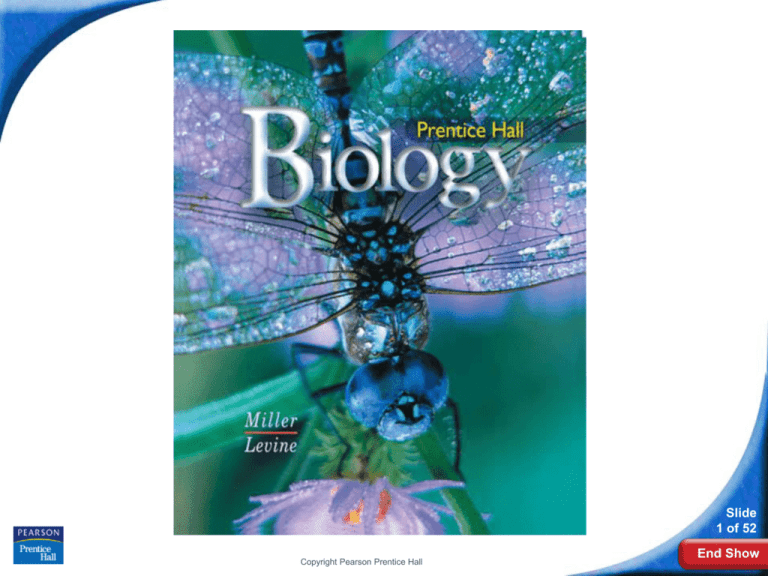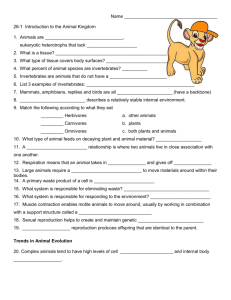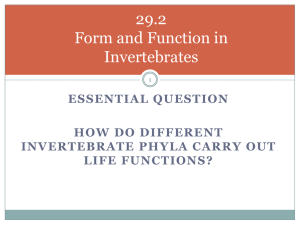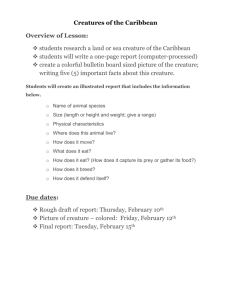
Biology
Slide
1 of 52
Copyright Pearson Prentice Hall
End Show
29-2 Form and Function
in Invertebrates
Slide
2 of 52
Copyright Pearson Prentice Hall
End Show
29-2 Form and Function in
Invertebrates
Form and Function
How do different invertebrate phyla
carry out life functions?
Slide
3 of 52
Copyright Pearson Prentice Hall
End Show
29-2 Form and Function in
Invertebrates
Feeding and Digestion
Feeding and Digestion
The simplest animals break down food
primarily through intracellular digestion.
More complex animals use extracellular
digestion.
Slide
4 of 52
Copyright Pearson Prentice Hall
End Show
29-2 Form and Function in
Invertebrates
Feeding and Digestion
When food is digested inside cells, this process is
known as intracellular digestion.
Sponges use intracellular digestion.
Slide
5 of 52
Copyright Pearson Prentice Hall
End Show
29-2 Form and Function in
Invertebrates
Feeding and Digestion
In extracellular digestion, food is broken down
outside the cells in a digestive cavity or tract and then
absorbed into the body.
Mollusks, annelids, arthropods, and echinoderms rely
almost entirely on extracellular digestion.
Flatworms and cnidarians use both intracellular and
extracellular digestion.
Slide
6 of 52
Copyright Pearson Prentice Hall
End Show
29-2 Form and Function in
Invertebrates
Feeding and Digestion
Cnidarians and most flatworms ingest food and expel
wastes through a single opening.
Food is digested in a cavity through both extracellular
and intracellular means.
Slide
7 of 52
Copyright Pearson Prentice Hall
End Show
29-2 Form and Function in
Invertebrates
Feeding and Digestion
Invertebrate Digestive Systems
Mouth/anus
Gastrovascular cavity
Digestive
cavity
Cnidarian
Pharynx
Mouth/anus
Copyright Pearson Prentice Hall
Flatworm
Slide
8 of 52
End Show
29-2 Form and Function in
Invertebrates
Feeding and Digestion
In more-complex animals, food enters the mouth and
wastes leave through the anus.
A one-way digestive tract often has specialized
regions.
Slide
9 of 52
Copyright Pearson Prentice Hall
End Show
29-2 Form and Function in
Feeding and Digestion
Invertebrates
Intestine
Gizzard
Crop
Pharynx
Mouth
Annelid
Anus
Pharynx
Crop
Anus
Arthropod
Mouth
Stomach and
digestive glands
Copyright Pearson Prentice Hall
Rectum
Intestine
Slide
10 of 52
End Show
29-2 Form and Function in
Invertebrates
Respiration
Respiration
All respiratory systems have two basic
requirements:
• a large surface area that is in contact
with the air or water
• the respiratory surfaces must be moist
for diffusion to occur
Slide
11 of 52
Copyright Pearson Prentice Hall
End Show
29-2 Form and Function in
Invertebrates
Respiration
Aquatic Invertebrates
Many animals respire through their skin.
Aquatic mollusks, arthropods, and many
annelids exchange gases through gills.
Slide
12 of 52
Copyright Pearson Prentice Hall
End Show
29-2 Form and Function in
Invertebrates
Respiration
Gills are feathery structures that expose a large
surface area to the water.
Slide
13 of 52
Copyright Pearson Prentice Hall
End Show
29-2 Form and Function in
Invertebrates
Respiration
Terrestrial Invertebrates
Terrestrial invertebrates have several types of
respiratory surfaces.
Many spiders have book lungs.
Slide
14 of 52
Copyright Pearson Prentice Hall
End Show
29-2 Form and Function in
Invertebrates
Respiration
Grasshoppers and other insects have spiracles and
tracheal tubes.
Slide
15 of 52
Copyright Pearson Prentice Hall
End Show
29-2 Form and Function in
Invertebrates
Circulation
Circulation
Most complex animals have one or
more hearts to move blood through
their bodies and either an open or
closed circulatory system.
Slide
16 of 52
Copyright Pearson Prentice Hall
End Show
29-2 Form and Function in
Invertebrates
Circulation
Open Circulatory Systems
In an open circulatory system, blood is only
partially contained within a system of blood
vessels.
One or more hearts or heartlike organs pump
blood through blood vessels into a system of
sinuses, or spongy cavities.
The blood makes its way back to the heart.
Slide
17 of 52
Copyright Pearson Prentice Hall
End Show
29-2 Form and Function in
Invertebrates
Circulation
Open circulatory systems are characteristic of
arthropods and most mollusks.
Slide
18 of 52
Copyright Pearson Prentice Hall
End Show
29-2 Form and Function in
Invertebrates
Circulation
Closed Circulatory Systems
In a closed circulatory system, a heart or
heartlike organ forces blood through vessels that
extend throughout the body.
Materials reach body tissues by diffusing across
the walls of the blood vessels.
Closed circulatory systems are characteristic of
larger, more active animals.
Slide
19 of 52
Copyright Pearson Prentice Hall
End Show
29-2 Form and Function in
Invertebrates
Circulation
Among the invertebrates, closed circulatory systems
are found in annelids and some mollusks.
Heartlike structure
Small vessels in tissue
Blood vessels
Annelid: Closed
Circulatory System
Heartlike structures
Copyright Pearson Prentice Hall
Slide
20 of 52
End Show
29-2 Form and Function in
Invertebrates
Excretion
Excretion
Most animals have an excretory system
that rids the body of metabolic wastes
while controlling the amount of water in
the tissues.
In aquatic invertebrates, ammonia diffuses
from their body tissues into the surrounding
water.
Slide
21 of 52
Copyright Pearson Prentice Hall
End Show
29-2 Form and Function in
Invertebrates
Excretion
Flatworms use a network of flame cells to eliminate
excess water.
Flame Cells
Excretory
tubules
Flame Cell
Excretory tubule
Flatworm
Slide
22 of 52
Copyright Pearson Prentice Hall
End Show
29-2 Form and Function in
Invertebrates
Excretion
In annelids and mollusks, urine forms in tubelike
structures called nephridia.
Nephrostome
Excretory pore
Annelid
Nephridia
Slide
23 of 52
Copyright Pearson Prentice Hall
End Show
29-2 Form and Function in
Invertebrates
Excretion
Fluid enters the nephridia through openings called
nephrostomes.
Urine leaves the body through excretory pores.
Urine is highly concentrated, so little water is lost.
Slide
24 of 52
Copyright Pearson Prentice Hall
End Show
29-2 Form and Function in
Invertebrates
Excretion
Some insects and arachnids have Malpighian
tubules, saclike organs that convert ammonia into
uric acid.
Digestive tract
Arthropod
Malpighian
tubules
Slide
25 of 52
Copyright Pearson Prentice Hall
End Show
29-2 Form and Function in
Invertebrates
Excretion
Uric acid and digestive wastes combine to form a
thick paste that leaves the body through the rectum.
The paste helps to reduce water loss.
Slide
26 of 52
Copyright Pearson Prentice Hall
End Show
29-2 Form and Function in
Invertebrates
Response
Response
Invertebrates show three trends in the
evolution of the nervous system:
centralization, cephalization, and
specialization.
Slide
27 of 52
Copyright Pearson Prentice Hall
End Show
29-2 Form and Function in
Invertebrates
Response
Centralization and Cephalization
Cephalization is the concentration of nerve tissue
and organs in one end of the body.
Slide
28 of 52
Copyright Pearson Prentice Hall
End Show
29-2 Form and Function in
Invertebrates
Cnidarians have nerve
nets which consist of
individual nerve cells that
form a netlike
arrangement throughout
the animal’s body.
Response
Nerve cells
Cnidarian
Slide
29 of 52
Copyright Pearson Prentice Hall
End Show
29-2 Form and Function in
Invertebrates
Response
In flatworms and
roundworms, the nerve
cells are more
centralized.
Ganglia
There are a few clumps
of nerve tissue, or
ganglia, in the head.
Flatworm
Slide
30 of 52
Copyright Pearson Prentice Hall
End Show
29-2 Form and Function in
Invertebrates
In cephalopod mollusks
and arthropods, ganglia
are organized into a
brain.
Response
Brain
Ganglia
Arthropod
Brain
Mollusk
Slide
31 of 52
Copyright Pearson Prentice Hall
End Show
29-2 Form and Function in
Invertebrates
Response
Specialization
The more complex an animal’s nervous system is,
the more developed its sense organs tend to be.
Complex animals may have a variety of
specialized sense organs that detect light, sound,
chemicals, movement, and electricity.
Slide
32 of 52
Copyright Pearson Prentice Hall
End Show
29-2 Form and Function in
Invertebrates
Movement and Support
Movement and Support
Most animals use muscles to move, breathe, pump
blood, and perform other life functions.
In most animals, muscles work together with some
sort of skeletal system that provides firm support.
Slide
33 of 52
Copyright Pearson Prentice Hall
End Show
29-2 Form and Function in
Invertebrates
Movement and Support
Invertebrates have one of three main
kinds of skeletal systems: hydrostatic
skeletons, exoskeletons, or
endoskeletons.
Slide
34 of 52
Copyright Pearson Prentice Hall
End Show
29-2 Form and Function in
Invertebrates
Movement and Support
Hydrostatic Skeletons
In a hydrostatic skeleton, muscles surround a
fluid-filled body cavity that supports the muscles.
When the muscles contract, they push against fluid
in the body cavity, causing the body to change
shape.
Annelids and certain cnidarians, have hydrostatic
skeletons.
Slide
35 of 52
Copyright Pearson Prentice Hall
End Show
29-2 Form and Function in
Invertebrates
Movement and Support
Hydrostatic
Skeleton
Circular muscles
contracted
Water
Longitudinal
muscles
contracted
Copyright Pearson Prentice Hall
Water
Slide
36 of 52
End Show
29-2 Form and Function in
Invertebrates
Movement and Support
Exoskeletons
An exoskeleton, or external skeleton, is a hard
body covering made of chitin.
Arthropods have exoskeletons.
Arthropods move by using muscles that are
attached to the inside of the exoskeleton.
Slide
37 of 52
Copyright Pearson Prentice Hall
End Show
29-2 Form and Function in
Invertebrates
Movement and Support
Exoskeleton
Flexed joint
Extended joint
Slide
38 of 52
Copyright Pearson Prentice Hall
End Show
29-2 Form and Function in
Invertebrates
Movement and Support
Endoskeletons
An endoskeleton is a structural support located
inside the body.
Sea stars and other echinoderms have an
endoskeleton. Vertebrates also have
endoskeletons.
Slide
39 of 52
Copyright Pearson Prentice Hall
End Show
29-2 Form and Function in
Invertebrates
Movement and Support
Endoskeleton
Skeletal plates
Tube foot
Slide
40 of 52
Copyright Pearson Prentice Hall
End Show
29-2 Form and Function in
Invertebrates
Sexual and Asexual Reproduction
Sexual and Asexual Reproduction
Most invertebrates reproduce sexually
during at least part of their life cycle.
Depending on environmental conditions,
however, many invertebrates may also
reproduce asexually.
Slide
41 of 52
Copyright Pearson Prentice Hall
End Show
29-2 Form and Function in
Invertebrates
Sexual and Asexual Reproduction
Sexual reproduction maintains genetic diversity in a
population.
Asexual reproduction allows animals to reproduce
rapidly and take advantage of favorable conditions in
the environment.
Slide
42 of 52
Copyright Pearson Prentice Hall
End Show
29-2 Form and Function in
Invertebrates
Sexual and Asexual Reproduction
Sexual reproduction is the production of offspring
from the fusion of gametes.
Male and female gametes join to create a zygote.
The zygote grows through mitosis and develops into
a multicellular animal.
Slide
43 of 52
Copyright Pearson Prentice Hall
End Show
29-2 Form and Function in
Invertebrates
Sexual and Asexual Reproduction
In most animals, each individual is a single sex.
The individual produces either sperm or eggs.
Some animals are hermaphrodites—individuals that
produce both sperm and eggs.
Slide
44 of 52
Copyright Pearson Prentice Hall
End Show
29-2 Form and Function in
Invertebrates
Sexual and Asexual Reproduction
In external fertilization, eggs are fertilized outside
the female’s body.
In internal fertilization, eggs are fertilized inside the
female’s body.
Slide
45 of 52
Copyright Pearson Prentice Hall
End Show
29-2 Form and Function in
Invertebrates
Sexual and Asexual Reproduction
The offspring of asexual reproduction grow into
multicellular organisms by mitosis of diploid cells.
Some animals reproduce asexually through budding
or by dividing in two.
Slide
46 of 52
Copyright Pearson Prentice Hall
End Show
29-2
Click to Launch:
Continue to:
- or -
Slide
47 of 52
End Show
Copyright Pearson Prentice Hall
29-2
Flatworms eliminate excess water using a
network of
a. flame cells.
b. Malpighian tubules.
c. nephridia.
d. madrepores.
Slide
48 of 52
End Show
Copyright Pearson Prentice Hall
29-2
A hydrostatic skeleton is found in the
a. annelids.
b. echinoderms.
c. arthropods.
d. insects.
Slide
49 of 52
End Show
Copyright Pearson Prentice Hall
29-2
Complex animals break down food using
a. intracellular digestion.
b. extracellular digestion.
c. intracellular digestion and extracellular
digestion.
d. digestion outside of the body.
Slide
50 of 52
End Show
Copyright Pearson Prentice Hall
29-2
Which structures are involved in gas exchange
in one or more groups of invertebrates?
a. ganglia, brain, and nerve cells
b. gills, book lung, skin, and tracheal tubes
c. nephridia, flame cells, and nephrostomes
d. pharynx, crop, and intestine
Slide
51 of 52
End Show
Copyright Pearson Prentice Hall
29-2
Which groups have only one entrance and exit
point to the digestive system?
a. annelids and echinoderms
b. arthropods and roundworms
c. mollusks and sponges
d. flatworms and cnidarians
Slide
52 of 52
End Show
Copyright Pearson Prentice Hall
END OF SECTION









